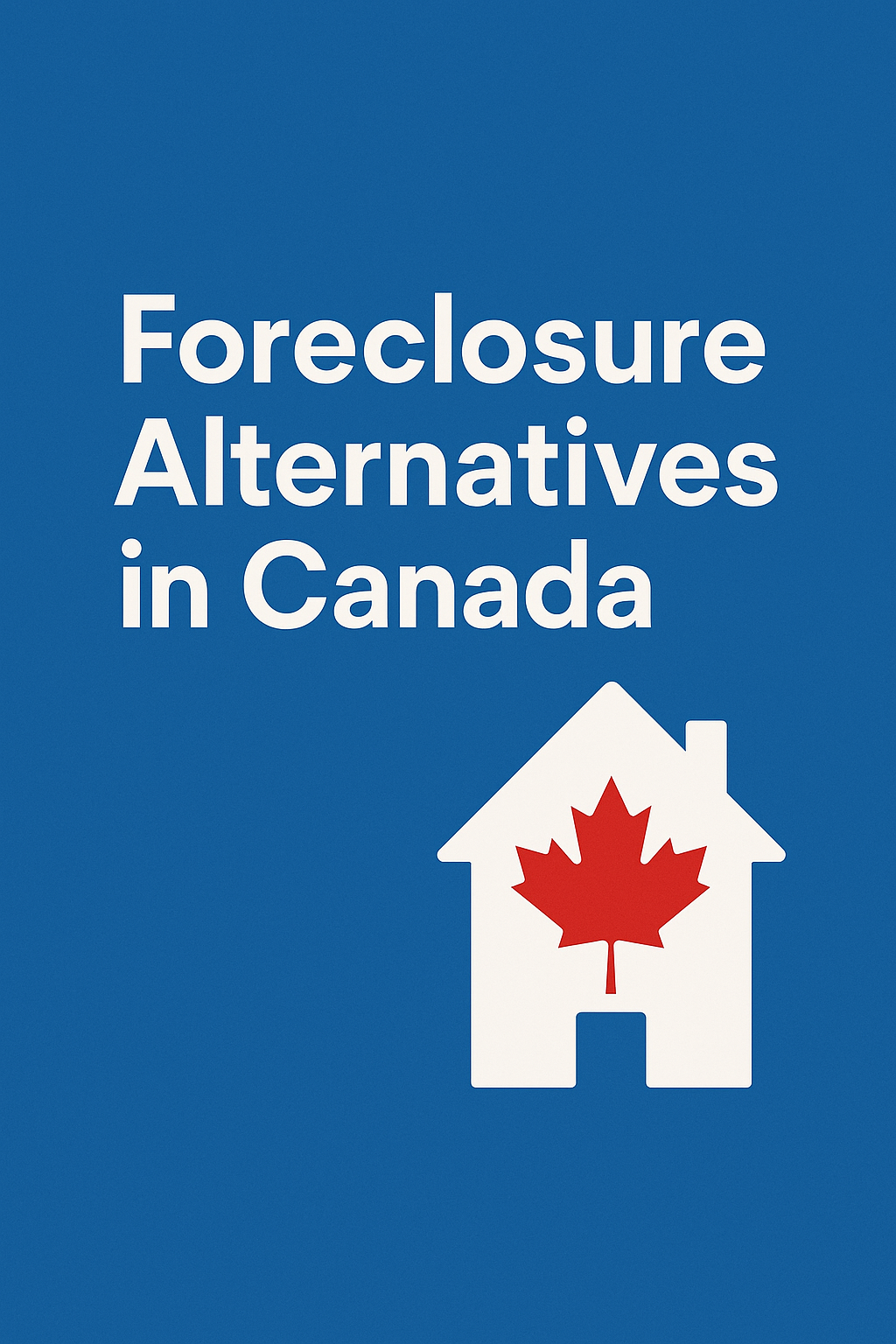Table of Contents
ToggleForeclosure Alternatives in Canada: 9 Practical Ways to Stop a Power of Sale (and Keep Your Equity)
When mortgage payments slip, the fear of foreclosure (or, in Ontario, more commonly a power of sale) can feel overwhelming. The good news: you often have options to pause, restructure, or replace your mortgage before you lose the home—or the equity you’ve built. This guide breaks down the most effective foreclosure alternatives Canadian homeowners use to regain control, protect their credit, and stay on track.
If you’re in Ontario, get familiar with the process first: lenders typically use power of sale rather than court-based foreclosure. Understanding the steps and timelines helps you act before costs snowball. See Power of Sale in Ontario: What Homeowners Need to Know.
Step Zero: Get Clear on Your Timeline
Before choosing an option, pin down:
-
Where you are in the process (missed-payment notice, demand letter, Notice of Sale, etc.).
-
How much you have to pay to reinstate (arrears, late fees, legal costs)
-
Deadline to act before the property is listed or sold.
If you’re already under legal pressure, review time-sensitive strategies in How to Get Out of Power of Sale in Ontario—then return to the alternatives below to choose the best fit.
1) Reinstate or Set a Repayment Plan with Your Lender
Best for: Short-term hardship (job gap, medical bill, temporary expense spike).
How it works: You catch up arrears in a lump sum or enter a formal repayment plan that spreads arrears over several months in addition to your regular payment.
Why it helps: It’s the fastest, least expensive reset—especially if you act before legal fees mount. Prepare proof of income, a written budget, and a clear catch-up proposal so the lender can say “yes” quickly.
What to watch for: Missing a repayment-plan milestone can trigger the process again. If income is uncertain, consider options with payment flexibility (see #4 and #5).
2) Refinance to Consolidate Debts (and Lower Total Payments)
Best for: Homeowners with equity who are juggling high-interest credit cards, loans, or tax arrears.
How it works: Replace your current mortgage with a new mortgage that pays off the old balance plus arrears and other debts. The goal is one payment at a lower blended rate than your unsecured debt.
Why it helps: A refinance can immediately stop collection pressure, simplify cash flow, and reduce total interest over time. It’s especially useful if your first mortgage has a good rate but you’re drowning in other bills.
Next step: Explore scenarios in Building Financial Freedom: How Refinancing Your Home to Pay Off High-Interest Debt Buys Your Time Back.
What to watch for: If you’re mid-term on a fixed mortgage, factor in prepayment penalties. A broker can compare “refi now” vs. “short-term second mortgage then refi at renewal.”
3) Take a Second Mortgage to Bridge the Gap
Best for: Urgent arrears where a full refinance isn’t possible yet (credit bruised, income in transition), or when breaking your first mortgage would be too costly.
How it works: A second mortgage (or home equity loan) sits behind your first mortgage to bring your account current, pay legal fees, and sometimes consolidate urgent debts.
Why it helps: You preserve your existing first-mortgage rate, stop the power-of-sale clock, and buy 6–24 months to rebuild credit before rolling everything into a single, better mortgage later.
Watch-outs: Rates and fees are higher than first-mortgages. Treat this as short-term triage with a clear exit plan (sale, refinance, or renewal window).
4) Open a HELOC for Flexible Access to Funds
Best for: Owners with solid equity who need ongoing flexibility—irregular income, variable expenses, or a need to keep payments low.
How it works: A Home Equity Line of Credit (HELOC) gives revolving access to funds up to a set limit; you pay interest only on what you actually use.
Why it helps: A HELOC can cover arrears and prevent future shortfalls without restructuring your first mortgage. It’s also an efficient way to catch up on property-tax arrears or utilities that threaten legal action.
Next step: Learn how HELOCs work and how they’re registered on title on the Home Equity Line of Credit (HELOC) page.
What to watch for: Rates are usually variable. Build a payment buffer and plan to pay down principal once you’re stable so the balance doesn’t linger.
5) Consider a Consumer Proposal (to Cut Unsecured Debt)
Best for: House-rich, cash-flow-poor owners whose main problem is unsecured debt—credit cards, lines of credit, collections—more than the mortgage itself.
How it works: Through a Licensed Insolvency Trustee, you negotiate to repay a portion of unsecured debt over up to five years, freezing interest and stopping most collection actions.
Why it helps: Slashing unsecured payments can free enough cash to maintain your mortgage and halt the cascade toward power of sale—without selling your home.
Good to know: Your mortgage can continue as agreed if you keep payments current; the lender generally can’t change it just because you filed a proposal. Read Will a Consumer Proposal Affect Your Mortgage in Ontario? for nuances and lender expectations.
What to watch for: A proposal impacts your credit during the term and for a period afterward, but it’s often less severe than bankruptcy—and may be the cleanest path to keep the home.
6) Ask for a Temporary Payment Deferral or Modification
Best for: Documented, temporary hardship (job loss with EI starting, medical leave, sudden caregiving).
How it works: Your lender may allow a short payment deferral, interest-only payments, or a term extension to reduce monthly costs.
Why it helps: It buys time to recover income or finish a refinance—without triggering legal proceedings.
What to watch for: Deferrals typically capitalize interest (it’s added to your principal), so use sparingly and pair with a plan (e.g., approved refi closing date).
7) Sell Proactively (Before Legal Costs Eat Your Equity)
Best for: Negative cash flow that won’t improve soon, or very thin equity.
How it works: List the property before the power of sale so you control the sale price and timeline. You’ll usually net more than if a lender sells under pressure.
Why it helps: Preserves credit, reduces stress, and can leave you with a healthy down payment for a right-sized home or rental.
What to watch for: Be realistic about pricing. If you need time to prepare the home for the market, combine this plan with short-term financing (see #3) to stop legal action while you sell.
8) Fix Property-Tax Arrears and Utility Liens Early
Best for: Homeowners behind on municipal taxes or utilities.
How it works: Use a HELOC, second mortgage, or refinance to clear arrears and remove the threat of a tax sale or lien escalation.
Why it helps: Municipal charges accrue interest and penalties quickly—and can jump ahead of your lender’s priority. Clearing them often unlocks approvals for refinancing and HELOCs.
Tip: If tax arrears are your main issue, mention this upfront when you speak with a broker; it can change which lenders and products are available.
9) Combine Strategies for a Smoother Exit
Real life isn’t either/or. Many homeowners use a hybrid approach, such as:
-
Second mortgage (6–18 months) → credit rebuild → full refinance at renewal
-
Short HELOC draw for arrears → consumer proposal to reduce unsecured payments → HELOC paydown plan
-
Payment deferral (60–90 days) → sale prep → proactive listing to maximize net equity
Documents That Speed Up Approvals
Lenders move faster—and are more flexible—when you’re organized. Gather:
-
Recent mortgage statements, arrears letter, and any legal correspondence
-
Property-tax statement, utility arrears notices, condo status letter (if applicable)
-
Income proof (pay stubs, pension statements, NOAs, T1 General if self-employed)
-
Two pieces of ID, a recent credit report if available
-
List of debts and monthly payments (to target debt consolidation in a refi or second)
Mistakes That Make Power of Sale Worse
-
Waiting too long. Legal and realtor fees stack up fast once a file goes “in-house” or to external counsel.
-
Ignoring property taxes. Municipal arrears jeopardize deals—fix them early.
-
Choosing the wrong tool. For short-term cash gaps, a second mortgage or HELOC often beats breaking a low-rate first mortgage.
-
No exit plan. Every short-term solution needs a clear path to refinance, sale, or term reset.
How to Choose Your Best Foreclosure Alternative (Fast)
-
Map your deadlines. How many days until the next legal step?
-
Confirm equity and credit. A broker can estimate loan-to-value (LTV) and prepayment penalties within minutes.
-
Pick the least-disruptive fix that actually solves the root cause (arrears only vs. full debt load).
-
Get approvals in parallel. Ask your broker to explore refi + second + HELOC simultaneously so you can choose the first approval that fits.
-
Lock the exit plan. Calendar the refinance, renewal, or sale date before you sign anything short-term.
We’re Here to Help
If you’re facing missed payments, act now—even a short call can change the trajectory. LendToday brokers work with mainstream, alternative, and private lenders, so you see all your options in one place. Start by reviewing the process in Power of Sale in Ontario and quick tactics in How to Get Out of Power of Sale, then explore financing paths like refinancing to consolidate debt or a flexible HELOC. If unsecured debts are crushing your budget, read Will a Consumer Proposal Affect Your Mortgage in Ontario? and speak with a Licensed Insolvency Trustee.
Bottom line: You have more than one way to stop foreclosure/power of sale, safeguard your credit, and keep your home. The right solution depends on your equity, income stability, and deadlines—but with the right plan and lender, you can move from panic to a clear path forward in days, not months.
This article is for education only and not legal advice. Program terms and lender policies change. Consult qualified professionals for guidance tailored to your situation.
- Mortgage Co-Signer vs Guarantor in Canada: Expert Playbook to a Smarter Approval in 2025 - September 24, 2025
- 7 Powerful Steps to Rent-to-Own Success: How to Qualify for a Mortgage and Exercise Your Option to Purchase - September 22, 2025
- Refinance Your Home Should be 1st Choice to Consolidate Debt: A Smarter Path Than Consumer Proposals or Bankruptcy - September 20, 2025






